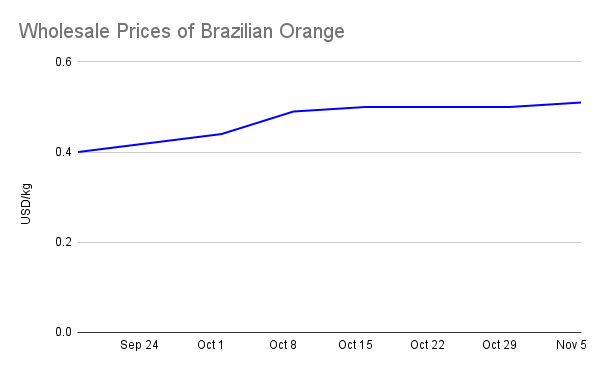Challenges in Global Orange Juice Production Fuel Historic Price Surges

The orange juice market is undergoing significant disruptions, largely due to unfavorable weather conditions and the impact of diseases affecting the major producing countries, including Brazil, the United States (US), and Mexico. Brazil holds a substantial market share, accounting for 75% of the global trade in orange juice. The production challenges facing Brazil are of particular significance as they could significantly impact the global supply of orange juice. Any disruptions in Brazil's production can reverberate across the entire market, given its prominent position in the industry.
In the US, the state of Florida, a significant producer of orange juice, has experienced diminished production levels due to the impact of hurricanes in recent years. This situation has resulted in historically low production levels, contributing to the overall decrease in orange juice availability. The forecast for Mexico's frozen concentrated orange juice (FCOJ) production in 2022–23 is anticipated to be 176,000 metric tons (mt). This forecast represents a decline from the previous year's production, estimated at 215,000 mt. Based on projections from the United States Department of Agriculture (USDA), the data points to a reduction in Mexico's orange juice output, adding to the global supply constraints.
The surge in orange juice prices, specifically the all-time high experienced in late October, reflects the severity of the production challenges facing these major producing countries. This increase is evident in both the futures contracts and the spot prices for orange juice. Prices for orange juice surged to their highest levels on record, with the January contract of FOCJ OJc2 reaching an unprecedented peak of USD 4.17 per pound (lb) during a session on October 31. Although it later regressed to USD 3.83/lb, this price still stood at an all-time high. This stark escalation, coupled with the fact that the contract had climbed by 90% throughout the year, denotes a substantial rise in value, making the trade notably profitable.
This scarcity is directly affecting orange juice wholesale rates. Notably, a significant month-on-month (MoM) increase in prices has been observed in Brazil and the US. In Brazil, the transition in pricing dynamics is apparent in Tridge’s Transaction Data Service (TDS), indicating a significant increase in wholesale rates for orange juice from the Rio Grande do Sul market. There was a substantial month-on-month (MoM) rise of 20.2% from the price of BRL 2.08 per kilogram (kg) recorded on September 25 to BRL 2.50/kg by October 23. Likewise, the US witnessed a noteworthy surge in the spot price of orange juice due to production challenges in Florida. The price soared to USD 4.02/lb on October 23, reflecting a 15.2% increase from the USD 3.49/lb noted on September 25. This substantial surge in pricing serves as an indication of the challenges and decreased production capacities faced by these primary orange juice-producing nations.

The prevailing scenario seems unlikely to shift in the upcoming years due to the continued spread of the greening disease in the US and Brazil. This ongoing challenge poses a significant risk to orange production in these key regions. In Brazil, citrus producers are cautious about expanding their orchards due to concerns about potential financial losses arising from the greening disease, as reported by CitrusBR. Therefore, orange juice prices are expected to remain elevated for the remaining duration of the year.
For further reading, follow the links below:



